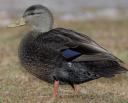The American black duck is also called “black mallard” or “red leg.” Plumage is a dark, mottled brown with white underwings and a violet-blue speculum. It’s length is 21-26 inches and its average weight is anywhere from 2.4-2.8 pounds. When visibility is good, the contrast between the light-brown head and the brown-black body is noticeable. This is our only puddle duck in which the plumages of both sexes are almost identical; the drake in nuptial plumage has a bright yellow bill, contrasting with the female’s olive-green bill. The voice of the hen is a loud quack; of the drake, a lower-pitched kwek-kwek.
Black ducks eat a variety of vegetable foods, including eelgrass, widgeon grass, and the seeds of sedges, bulrushes, wild rice, pondweeds, smartweeds and millets. On land they feed on acorns and waste corn, willingly flying up to 25 miles to a reliable source of the latter. Animal foods, more important in winter, include periwinkles, mussels, and snails.
Black ducks breed in Pennsylvania, nesting in marshes, bogs, and lake and stream margins, and often in wooded uplands They nest on the ground, on stumps and dead snags, and occasionally in tree cavities; eggs, 8-10, hatch in about 4 weeks.
Once considered the number one duck in the waterfowl hunter’s bag, the black duck has dropped in popularity to third place, behind the mallard and wood duck. The black duck population declined steadily in the 1960s and ’70s. In 1982, harvest restrictions were implemented and the population appears to have stabilized, but is well below its historic numbers.
